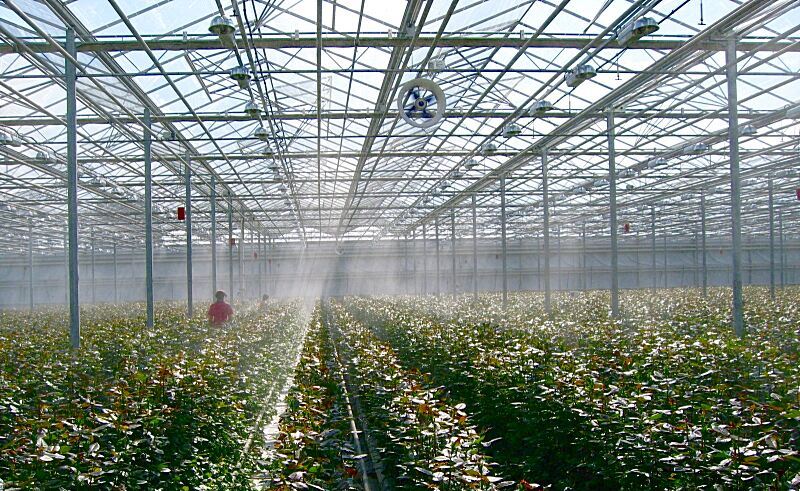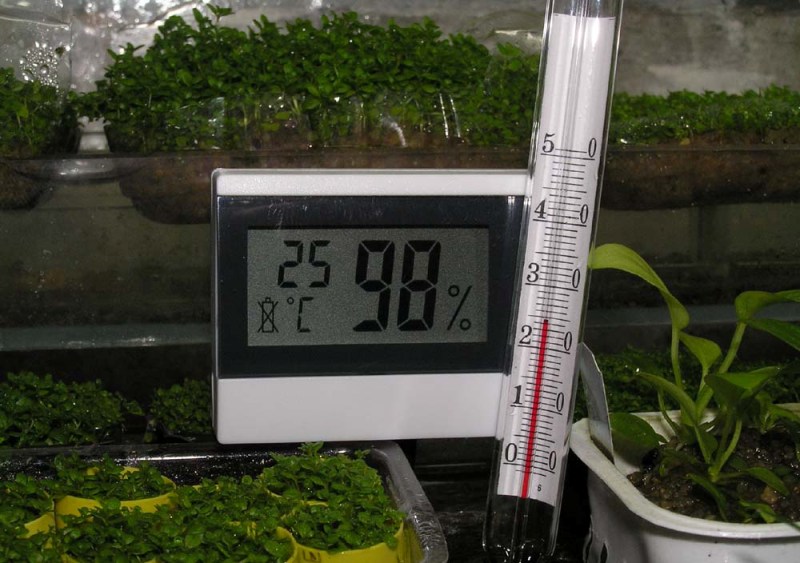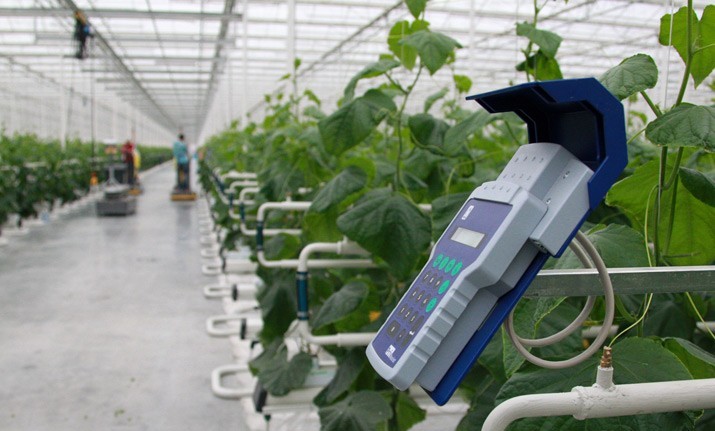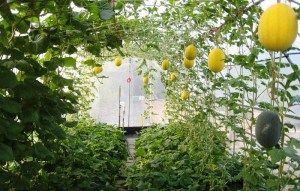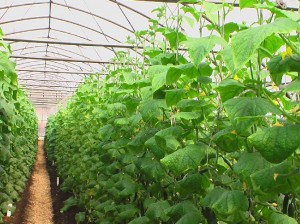How do you control these fluctuations?
Automatic temperature control
Visually observing all the necessary parameters inside the greenhouse is a complex, time-consuming and responsible task.
This fact often leads gardeners to the need to automate these processes. The purchase of a regulator eliminates the need for hourly control, measurement of all parameters. It's not the cheapest way, but it pays off.
Today the market offers three types of thermostats:
- mechanical
- electronic
- sensory
The most economical option is a mechanical thermostat that allows you to set and adjust the temperature yourself. It has a normal thermostat.
The electronic regulator more accurately controls the temperature, equipped with a display for convenience.
The touch regulator is the most reliable system that creates the required soil and air temperature day and night.
The choice of the type of regulator depends on several factors.
Choosing the best option for thermoregulation
When choosing, the most important are:
- power of the selected thermostat
- installation principles
- adjustment type
- functional features
- device appearance
Particular attention should be paid to the power of the device. It must exceed the calculated heating power of the soil.
For very large greenhouses, it is possible to install several thermostats with the division of the entire greenhouse into zones. Installation of such systems can be hidden, hinged.
If large investments in the greenhouse are not expected, then a simple regulator can be made independently.
Do-it-yourself automatic thermostat
For simple heating of the soil in the spring, you can make a simple regulator. It does not contain expensive parts.
Such devices have features:
- susceptibility to auto-generation
- lack of great precision
The role of the sensor is usually performed by a thermistor.
Thermostats help solve the problem of heating in the cold season. The summer months raise the question of greenhouse ventilation.
Temperature and humidity control in summer
For such control, two devices are required:
- psychrometer
- thermometer
An alcohol thermometer is required. It is better to hang it at the level of growth of green plants. If the greenhouse is large, divided into zones, then you need to purchase several thermometers.
The psychrometer measures the humidity in the greenhouse. Digital psychrometers are the most convenient in practice.
These devices allow you to control the microclimate in the greenhouse. To maintain an optimal climate, it is necessary to ensure ventilation of the greenhouse.
Automatic ventilation of the greenhouse
The presence in the greenhouse of doors, vents, windows allows natural ventilation. To automate such processes, use:
- electrical mechanisms
- mechanical devices
The mechanics are more cunning. Its work is based on the expansion of bodies with increasing temperature.
Thus, a wide field opens up for gardeners to improve and control microclimatic conditions in their greenhouses.
Features of care
In winter, you need to maintain an average daily temperature of 18 to 22 degrees. Overheating has a bad effect on tomatoes, eggplants and sweet peppers, and a cold snap can have a detrimental effect on radishes and cucumbers. On frosty days, greenhouses are not ventilated, when the temperature outside rises, the windows need to be opened 1-2 times a day.
Vegetables in the greenhouse are watered 2-3 times a week, when the soil dries out a little. It is advisable to use water at the same temperature as the air in the greenhouse. Cold water can cause shock and slow down the development of plants.
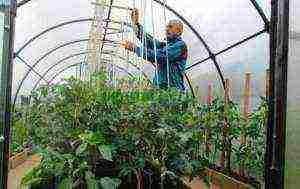
With the beginning of the formation of fruits, it is recommended to remove the lower leaves on the stems. Excessive green mass prevents the development of fruits. In addition, this technique will improve air exchange and access to sunlight, plants will not be affected by pests and fungus.
In a greenhouse, it is important to maintain an atmosphere conducive to plants. The level of humidity will help to increase the watering of the heating pipes and the floor with water, as well as the placement of open reservoirs in the room
For successful ripening of tomatoes in a greenhouse, you can put tanks with an aqueous solution of mullein. Well increase the humidity and barrels of hot water, besides, they additionally heat the room.
With conveyor growing, harvesting is carried out all year round. In early summer and late autumn, preventive treatment of premises is recommended with a partial replacement of the soil and a thorough washing of all surfaces. After airing and fertilizing, a new stage of planting begins.
The success of growing vegetables in a greenhouse in winter depends on the region. The most profitable option is the use of greenhouses in temperate climates. Regions with short summers and long frosty winters will require high heating costs.
In such an area, it is more expedient to extend the summer period until the end of October and practice early planting in heated soil. Using the right varieties of vegetable crops, you can achieve a good harvest.
Simple innovations in the design of greenhouses for growing vegetables all year round, in the video below:
In a small cottage or a large house adjoining area, there is always a place for a greenhouse, which can be used almost all year round, including the greenhouse off-season, for growing fresh herbs for the dining table.
In winter, in heated greenhouses in cold regions and unheated in the south, you can grow dill, parsley, lettuce, celery, and onions. Greens and onions, as a rule, belong to early-ripening vegetable crops with a short growing season, which allows you to harvest several crops during the autumn-winter season and always have greens on the table.
Greens grown in a greenhouse in winter. Lee A Reich
Simple winter greenhouse without special heating
For many years I tested different greenhouses and came to the conclusion that they all have one, but a significant drawback - they require a large amount of fuel to heat them.
I have been using a winter greenhouse without special heating for several years. I grow many types of crops and even subtropical and tropical plants in it.
We had to figure out how to get rid of these costs. I “shoveled” a mountain of literature, including old gardening textbooks, and came across an interesting fact. It turns out that in ancient times, greenhouses were made partially deepened into the ground. This resulted in significant fuel savings.
Having adopted the principle of "deepening", he built his own greenhouse, which does not need to be heated (see figure). Heat comes from the earth and partly from the sun's rays. True, there is an indispensable condition: the depth must correspond to at least twice the value of the soil freezing index in a given area. Otherwise, you will not achieve the desired thermal regime.
I dug a “pit” along the length from north to south, poured all the soil onto the western side. Actually, the length of the greenhouse can be any (I have it -10 meters). The side walls were well whitewashed with lime - this is both disinfection and an improvement in the light regime.
The ceiling was made of bars and poles at a distance of 40 to 60 centimeters. The thickness of the bars and the distance between them was determined in such a way that they would hold the snow load. I chose a thicker film for the upper floor and fixed it with planks nailed to the bars. On the inside I attached another layer of film. When severe frosts begin, somewhere at the end of December I stretch the third film layer. I cling to it at the top of the bars, and fix the lower ends below the freezing level of the soil.
Under these conditions, the unfrozen soil of the lower and side layers gives off its heat to the greenhouse. I don’t remove snow in severe frosts, only in some places I clean it off, I make “windows”. In early spring, I remove the “fur coat” completely.
This is how my greenhouse is simply arranged, in which I do not use a single gram of fuel. Even in the most severe frosts, when it is minus 32 outside, in the "winter house" under three layers of film the temperature does not drop below 0 degrees.
This is how I grow orange, tangerine, mimosa, roses, pomegranate, persimmon, tea, medlar, lavender and more. In spring and autumn, onions, parsley, and seedlings of garden crops grow well there. True, some "delicate" and tender plants have to pay a little more attention, to create a favorable regime of illumination and air humidity for them. But this is, as they say, trifles.
N. Tymush, Vinnytsia region
Back to the table of contents - Construction
What winter greenhouses are built from, methods of heating and lighting, what should be grown in winter
Today it is not a problem to enjoy a vegetable salad in the middle of winter: in stores all year round there is a rich assortment of plant products. But, besides the fact that the price for it is not the most affordable, and the taste qualities leave much to be desired, the benefits are also minimal, but it is quite possible to “enrich” the body with various chemistry. Therefore, despite the abundance of stores, winter greenhouses, which make it possible to grow eco-friendly and tasty vegetables or herbs for your family, have not lost their relevance. However, compared with summer greenhouses, winter ones are more difficult both in terms of construction and in terms of operation of the structure, and are more demanding on materials. The participants of our portal are mainly engaged in seasonal greenhouses, but they also have experience in the construction and use of year-round greenhouses.
- Structural features of winter greenhouses.
- Arrangement of winter greenhouses.
- What to grow in winter
Choice of vegetables
In the winter greenhouse, you can grow any crop, from popular tomatoes to head lettuce and herbs. Among the most popular and fruitful vegetables:
- cucumbers;
- tomatoes;
- radish;
- head lettuce;
- eggplant;
- Bell pepper;
- various varieties of cabbage;
- zucchini.
It should be borne in mind that crops have different requirements for humidity and temperature, so they need to be placed in separate greenhouses. For example, tomatoes and sweet peppers require moderate humidity (not higher than 60%) and frequent ventilation. This mode is detrimental to cucumbers, which need a humid and hot atmosphere.
In the cold season, the greenhouse effect with high humidity is easier to maintain.
Therefore, many novice gardeners focus on popular and productive crops that need just such a regime: cucumbers and radishes.
When choosing varieties, it is worth giving preference to hybrids cultivated specifically for greenhouses. These plants have a short growing season and do not require insect pollination. Most greenhouse varieties are characterized by good yield and resistance to pests.
Growing herbs in a greenhouse in winter
In the coldest and darkest time of the year, the body needs energy replenishment more than ever. Of course, you can go to the supermarket for green vitamins, but why not try to grow much tastier and healthier fresh greens yourself? It's quite easy!
Its growing season is short (a guarantee of harvesting several crops at once in the autumn-winter season), and the greens are quite resistant to temperature changes (you don’t even need round-the-clock heating in the greenhouse).
Basically, greens in greenhouses are grown not on the main area, but on racks, saving space. With a competent approach to the process, you will not only provide your family with vitamins, but you can also earn money by selling early greens.
Early greens for sale - learning to grow
Greens grown for sale should be bright, healthy and inexpensive.You will be happy to know that this is possible and will take a minimum of time.
Most often cultivated in a greenhouse in winter:
Bow on feather
For forcing onions on a feather, species with a very short dormant period or without it at all are used (they are ready to form a new crop immediately after harvesting) - multi-tiered, batun, chives, slime.
The onion is suitable for the usual soil mixture of peat and garden soil, fed with nitrogen fertilizer. The bulbs are cut to the shoulders and soaked for 15 minutes in heated water, after which they are immediately planted in prepared boxes with soil close to each other and watered abundantly.
The first week it is desirable to maintain the temperature within 10-15°C, then the daily rate is raised to 18-20°C. Watering is done as the soil dries up. Onions will expel feathers even in natural light, but they will turn out brighter and denser when illuminated with phytolamps.
Feather cutting is carried out as needed - under good conditions, you will remove the first crop in 25-30 days.
Salad
Another unpretentious plant for a winter greenhouse is lettuce. Without much effort on your part (moderate watering, minimal lighting, a temperature of about 15 ° C), you can harvest it every three weeks. The most suitable for such cultivation is watercress.
Rhubarb, chicory, chard and asparagus are also great winter greens. At the same time, they do not even need a lot of light - containers with rhizomes sprinkled with moist soil can be kept in the lowest, dimly lit areas of the greenhouse. The crop is harvested by cutting off the peripheral large leaves and leaving the young ones to grow.
Dill
Dill is also a fairly cold and shade tolerant crop, undemanding to the soil and suitable for winter growing in a greenhouse. It is more rational to use its early ripe varieties (Aurora, Redut, Gribovsky, Grenadier, Dalniy, etc.) for distillation, and sowing already germinated seeds into prepared grooves about 2 cm deep.
Dill can be planted alone or as a compactor for onions or lettuce. Loose, well-moistened soil is desirable for him, a temperature of at least 15 ° C and a complete absence of drafts are important. Before germination, moisten the soil daily with a sprayer, and then water the seedlings every 5-7 days when the topsoil dries. If you see excessive thickening of the area, carefully thin out the plantings.
You can get the first crop of dill in a month or two after sowing the seeds. After a particularly plentiful cut, you can feed the remaining bushes with a solution of ammonium nitrate (10 g per 10 liters of water).
Parsley
This is the most capricious of all the winter inhabitants of the greenhouse, requiring good lighting and a certain thermal regime. Of the two possible ways to grow parsley (from root crops or from seeds), we advise you to choose seed - this way there will be less worries.
Like dill, parsley in a greenhouse should be grown from already prepared, hardened and germinated seeds - this way you will shorten the pre-emergence period, which otherwise can drag on for a month and a half.
Parsley seeds are sown in grooves about 2 cm deep and lightly sprinkled with soil. After that, the sown area is well moistened with a spray gun.
In the process of growth, parsley needs a temperature in the range of 12-18 ° C (at higher values, the leaves will turn yellow and fade en masse). Also, do not allow waterlogging - watering is carried out only after the topsoil has dried.
Thick seedlings should be thinned out, until the rows close - regularly loosen and remove weeds.
As soon as the plants have reached a height of 10-15 cm, you can take the first crop. As in the previous case, if too much greenery was removed, it is worth feeding the remaining stumps with a solution of urea (a tablespoon per 10 liters of water).
What should be the winter greenhouse
Winter greenhouses are capital structures built on a foundation that can withstand both wind and snow loads.It can be both free-standing buildings and extensions with one blank wall. For example, to the utility block, if the orientation of the structure allows.
Foundation
The foundation of the greenhouse can be tape or from separate blocks, columnar and slab bases are less common. UWB is usually not done under separate greenhouses, but if this is a winter garden within a capital house, then such a foundation is fully justified. In terms of cost, a slight expansion of the building spot against the general background is not critical, and the heating circuit, laid down when pouring the slab, will simplify the further arrangement of the greenhouse.
To prevent the outflow of far from free heat through the base of the greenhouse, extruded polystyrene foam can be used during the construction of the foundation. The most effective is complex insulation - both the foundation tape and the soil under the greenhouse, in place of future beds. The use of insulation is especially important if soil heating is planned, EPS will prevent unnecessary consumption of thermal energy for heating the lower, unused soil layers. You can also use insulation to protect the north side.
The road is a spoon for dinner, and a green cucumber for the new year. Such an addition to the Russian proverb does not cause controversy. No conservation can replace vegetables grown in our own greenhouse.

Which method of heating is easy to perform and not too expensive? What technical innovations do greenhouse owners use to grow seedlings, vegetables and flowers? What are their pros and cons? We will answer all these questions in our review.
Tips for using a cold greenhouse in autumn and winter
With the onset of winter cold the main crop growing season is also coming to an end, as winter weather in much of the world is not at all conducive to the growth and development of most plants. However, the use of a greenhouse design allows you to significantly extend the growing season without fear of temperature and weather conditions.
The greenhouse makes it possible produce different crops all year round. An important point in the "winter" greenhouse cultivation is the presence or absence of active heating in the greenhouse during the winter period. A heated greenhouse in terms of temperature will, logically, be very different from an unheated one. This will determine not only which crops you can grow most fruitfully, but also how exactly you will need to use the greenhouse structure in cold weather and how to care for it.
Unheated, or, as it is also called, a cold greenhouse - this is a greenhouse room in which artificial heat sources are not involved. In winter, in such a greenhouse, a moderate “autumn” temperature is set in the region of about 15 degrees Celsius - the temperature level largely depends on the number of sunny days, since the sun will be the only source of heat, and there may not be very many such days in December-January. But due to the fact that the walls of the polycarbonate greenhouse will still retain heat, the microclimate inside the greenhouse will still be warmer than the temperature outside, even at night.
Therefore, the conditions of an unheated winter greenhouse suitable for growing not all types of horticultural crops. Cold greenhouse crops include all winter crops, as well as crops such as cabbage, garlic, radishes, carrots or parsley. That is, despite the cold outside, you have quite a few options.
One of the main advantages growing in a cold greenhouse is a high quality crop. As you know, growing at low temperatures makes the fruits strong, large, and more palatable.For example, citrus fruits such as lemon or orange are much juicier and healthier when grown at a lower temperature.
By planting a particular crop in winter, by spring you will have ears that have grown stronger from the February cold, which will begin to develop rapidly by the arrival of heat - this is another undoubted plus of “cold” cultivation.
Finally, the purely economic benefit from owning a cold greenhouse lies in the fact that heating is not needed for its full functioning. You do not have to spend money on energy consumption (for electricity and heating), which is a fairly relevant advantage today. You can even choose not to install any heating systems in the greenhouse at all and still use your greenhouse all year round. In summer, your greenhouse structure will be used in "normal mode", and in winter it will function as a "cold" greenhouse.
Cultivation on straw
If there is wheat straw that is not treated with herbicides, it can be used as a substrate and biofuel. Pressed straw in the form of bales is placed in furrows to a depth of 20 cm.
15 days before planting the straw is watered with hot water (40...60°C) in three steps: on the first day - 4-5 l; on the second - 3-4 l; on the third - 2-3 liters for each bale. Then scatter over the surface of each bale:
- on the first day, double superphosphate (200 g);
- on the second - ammonium nitrate (330 g), potassium sulfate (80 g), magnesium sulfate (40 g);
- on the third day - 240 g of fluffy lime.
Fertilizers are washed with irrigation water inside the bales.
In 3 days after washing the fertilizers, the straw warms up, and the temperature inside the bales reaches +35…45°C. After the temperature of the straw drops to + 30 ° C, cucumber or tomato seedlings can be planted in it.
When growing plants on pressed straw, it is necessary to increase the norms and terms of watering, preventing the substrate from drying out.
Straw bales are a good substrate for plants, they have a good ratio between the solid, liquid and gaseous phases, and for a long time a favorable thermal regime is maintained for the root system of plants.
The need for straw can be determined based on the dimensions of the bales: 40 × 50 × 90 cm, the weight of one bale is 20-25 kg.
- Useful articles
- Garden
- Gardener
- Greenhouse heating: climate control
Garden themes
Garden themes
New in rubric
Garden without weeds: from dream to reality
Late blight: causes and methods of combating brown rot
If cucumbers turn yellow: diagnosis and problem solving
Yacon - a valuable plant: cultivation and care
How to properly harvest carrots
2012-2019 Useful magazine Good-Tips.PRO (+18)
Temperature and yield direct relationship
At the very beginning of our article, we want to say right away that not only the air temperature in the greenhouse affects the yield of plants, but also the temperature of the soil (see Earth in the greenhouse: soil selection and care).
It is important to understand that various plants grow well and bear fruit strictly at a certain temperature.
Different plants - different temperatures
A bountiful harvest.
Many probably faced such a question that in a certain year some plants gave a rich harvest compared to other plants growing nearby.
It's all about the temperature, for some it was the most optimal, and for others it was either too high or too low.
Greenhouse - temperature advantage
But if on the open ground it is not possible to regulate the temperature for individual plants, then the greenhouse is a closed space in which it is possible to successfully regulate the temperature regime.
Proper placement of plants is an important task
That is why it is so important to properly plant plants in a greenhouse. If your greenhouse is large, then there will be a significant difference in temperature in various parts of it.
This can be successfully used by planting heat-loving plants in warmer places, and in cooler places, plants for which this temperature is optimal. For more information on how to grow different crops together, you can read: Peppers and Eggplants in the Same Greenhouse and Growing Cucumbers and Tomatoes in the Same Greenhouse).
As in the open field, in the greenhouse there is a temperature difference between day and night
This difference is very important. Too large fluctuations can adversely affect plants and lead to their diseases, and in some cases to death.
Our reference - the limit of night and day mode should not exceed 4 - 8 ° С.
What is good for greens is bad for the fruit
Lots of greenery, few fruits.
Depending on the type of plants, the daily air temperature in the greenhouse should be 16 - 25 °C. Temperature directly affects growth, for example, a temperature increase of 10 ° C will increase the growth of greenery.
Do not rejoice, the roots and fruits at the same time develop much worse.
Many fruits with a minimum of greenery.
An increase to 40 ° C leads to a depressed state and possible death of the entire plant.
We were talking about air temperature.
Air is important - soil is just as important
Thermometer in the greenhouse.
The temperature regime of the soil is also important and should be within 14 - 25 ° C, everything also depends on the type of plant.
- If the temperature regime of the soil drops and reaches 10 ° C, the plant will begin to experience phosphorus starvation.
- Too high a temperature, exceeding 25 ° C, leads to difficult absorption of moisture by the roots.
- With the right temperature regime, the root system of plants develops and functions correctly, which cannot affect the well-being of the whole plant.
temperature issue
Realizing that the temperature regime in the greenhouse is extremely important and the yield depends on it, many will wonder how to control the temperature and observe the most optimal regime in the greenhouse?
Automatic regulation - the solution to the temperature issue
Electronic device.
As is clear from the above, visual compliance with all parameters is a very difficult and responsible task.
- Therefore, the surest option would be to equip the greenhouse with automation.
- Automatic temperature control in the greenhouse will relieve you of the worries of hourly control and measurement of air and soil temperature parameters in various parts of the greenhouse.
Sometimes the temperature begins to rise above the required norm, and at this time you are not.
How to lower the temperature in the greenhouse to the required parameters?
Automation comes to the rescue. Currently, there are a large number of various electronic devices on sale, which we have already discussed earlier (see Thermoregulator for a greenhouse).
Growing parsley in a greenhouse
Preparation of parsley seeds
Parsley has a very long pre-emergence period, which, depending on the variety and growing conditions, is about 45 days. To reduce the pre-emergence period, parsley is best sown with sprouted seeds. To do this, before sowing, the seeds are kept for 5 days in a moist two-layer gauze.
Sprouted seeds are transferred for 10 days to a room with a temperature of +1°C. When sown, such seeds germinate on the 15-17th day and form the above-ground mass 3 times faster than with conventional sowing.
Parsley sowing
Divide the prepared substrate into furrows every 10 cm with a depth of 2 cm. Evenly after 4-5 cm we place the seeds in the furrows and cover them with soil, smoothing them with your hand.
After sowing, we moisten the soil through a sprayer so as not to wash the seeds out of the substrate. The air temperature is maintained within +12..+18°С not higher. At + 20 ° C, parsley leaves fade from overheating.
Parsley care in the greenhouse
If the seedlings are dense, we carry out thinning, leaving a distance between seedlings of at least 5 cm.
We water the parsley when the top layer dries out, as the plants do not tolerate high humidity.
Before closing the rows, loosen the soil and destroy the weeds. Feeding cannot be done.
For home use, an above-ground mass 10-12 cm high can be cut into greens.
After the first cut, we feed the remaining "hemp" of parsley with a solution of nitrogen-potassium fertilizers at the rate of 7-10 g / 10 l of warm water. During the cold period in the greenhouse, you can harvest a 5-fold crop of parsley, supplying the family with fortified greens all winter.
